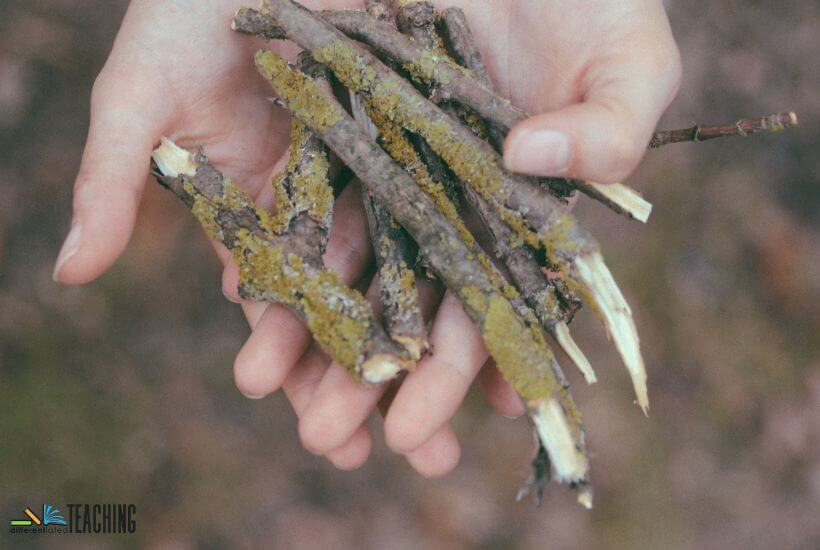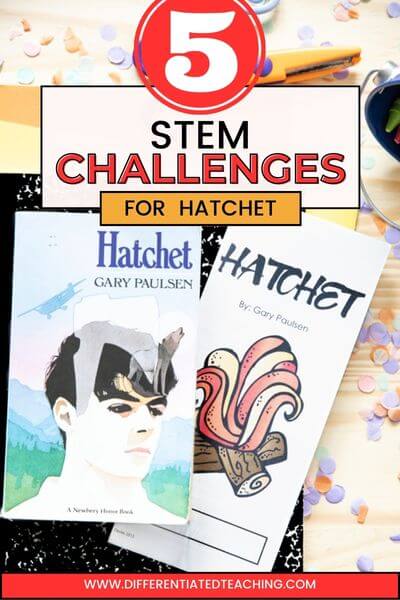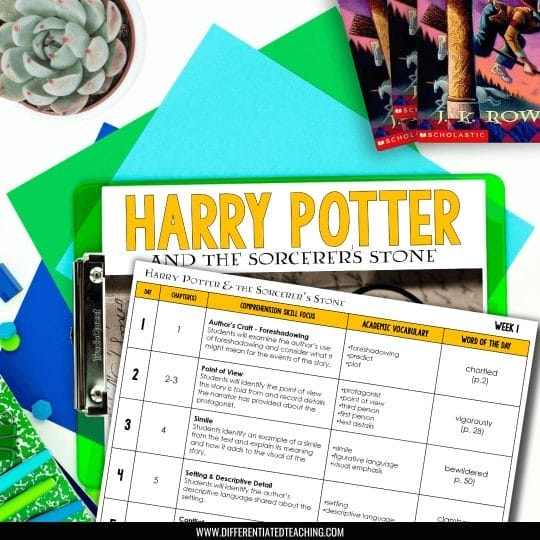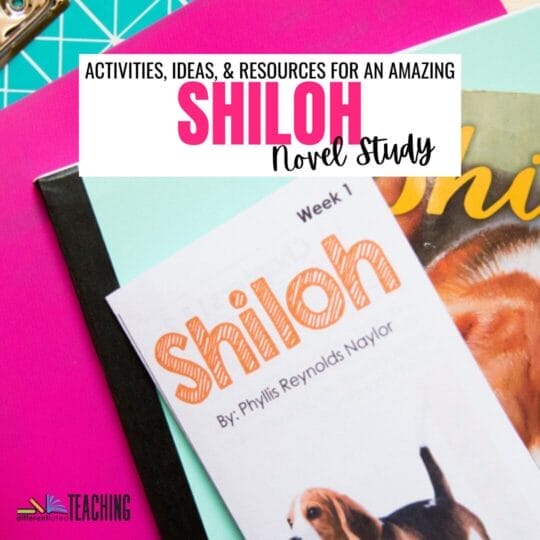5 Epic STEM Activities for Hatchet by Gary Paulsen to Increase Engagement
As teachers, we’re always searching for creative and effective ways to bring literature to life for our learners. The magic happens when we can mesh the world of fiction with real-world applications, fostering a deeper understanding and making learning more enjoyable for our students. When it comes to Gary Paulsen’s classic novel Hatchet, there’s a treasure trove of opportunities to do just that, especially in the world of Science, Technology, Engineering, and Mathematics—STEM.
Hatchet tells the captivating story of Brian, a 13-year-old boy who must survive in the Canadian wilderness after a plane crash. Brian’s reliance on his wits, the scientific method, and trial and error to survive provides a rich backdrop for meaningful STEM challenges.
In this blog post, we’ll explore five STEM activities inspired by Hatchet, making them a perfect way to wrap up your novel study unit. These activities are designed to help your students engage with the book’s themes on a deeper level, while also developing critical STEM skills.
Whether your students are long-time fans of the novel or are just discovering it for the first time, these challenges promise to add an exciting, hands-on element to your literature lessons. Ready to explore the STEM activities for Hatchet? Let’s dive in and unravel the mysteries of the wilderness together!
Bringing Literature to Life: STEM Activities for Hatchet
Integrating STEM activities into a literature lesson on Hatchet by Gary Paulsen can help bring the story to life and make it more meaningful for students. We’ll dive into not just one, but five meaningful STEM activities for Hatchet to enrich your classroom experience and build classroom community. So without further ado, here are some STEM activities related to the book that you can try out in your classroom:
1. Design and build a shelter using natural materials.
Doesn’t building a shelter using only natural materials sound like an adventure waiting to happen? This project is about embracing Brian’s spirit. Encourage your students to channel their inner survivalists and get their hands a little dirty.
Let’s set the scene: They’re in the wilderness, armed with branches, leaves, and maybe some mud.

Their task? To build a shelter sturdy enough to withstand the elements, just like Brian did. Guided by the vivid descriptions in the book, students will design and construct their own mini survival shelters.
Alternative: If you’ve got outdoor space near your school or you homeschool, you can also take a “field trip” and build outdoors in the woods like we did.
Now, the fun part: testing their creations. Simulate various weather conditions to see how well these shelters hold up. A hairdryer might become a gusty wind, and a spray bottle could mimic a heavy rainstorm – the sky’s the limit!
Remember, the goal isn’t just to construct a shelter, but to engage with the challenges Brian faced in Hatchet. It’s about problem-solving, creativity, and maybe even a little trial and error.
So, roll up your sleeves, and let’s get building!
2. Create a survival kit for Brian.
Who’s up for a thought experiment? Imagine being Brian, stranded in the wilderness with only your wits to rely on. What would be in your survival kit? Well, here’s a chance for your students to answer that question.
This project invites your students to step into Brian’s shoes and assemble a survival kit using items he might find in the wilderness. What could be more immersive and hands-on than that?
Encourage your students to research and learn about the different plants and animals Brian might encounter.
What are their uses and properties?
Which ones could aid in survival?
This is the perfect opportunity for your students to dig deep into nature’s toolbox, understanding how every creature or plant could be a lifesaver in the wild.
Remember, this activity isn’t just about identifying useful items; it’s about understanding why they’re useful. This task nurtures critical thinking, and problem-solving skills, and promotes an understanding of nature’s role in survival.
So let’s get started! What’s going into your survival kit?
3. Learn about the challenges of starting a fire WITHOUT matches.
A Quick Safety Note: While these STEM challenges for Hatchet are engaging and educational, this particular challenge involves fire, which can be dangerous. Homeschoolers, conduct these experiments in a controlled and safe environment, under the supervision of an adult. Teachers, follow all school & district safety protocols, and ensure that fire safety equipment (like a fire extinguisher) is readily available. You are responsible for all outcomes of these STEM activities for Hatchet. This website takes no responsibility for any safety or damages resulting from attempting these challenges. Therefore, remember, safety is the top priority! Let’s ignite curiosity, not flames, unless it’s safe and permitted.
Ever tried to start a fire with just sticks, leaves, and rocks? It’s trickier than it sounds! This next activity takes a leaf out of Brian’s book – quite literally – and challenges your students to do just that.
This experiment isn’t just fun; it’s educational. Students will gather natural materials, then test different fire-starting methods. Sparks might fly, or they might not, but students will learn about the principles of friction, combustion, and patience.
But here’s the real kicker: We’re turning this into a science experiment. Encourage students to record their observations, document their methodology, and analyze the data. Which materials worked best? Which method was most efficient?
Remember, this isn’t just about making a fire; it’s about understanding the science behind it, applying problem-solving skills, and building perseverance. Like Brian, we’re learning to survive, one spark at a time! So let’s strike that metaphorical flint and get started!
4. Research the flora & fauna of the Canadian wilderness.
Imagine being Brian, lost in the wilderness, with nature as your only company. What kinds of animals might you encounter? What plants would you find? Well, in this activity, your students will get to answer these questions and more.
Encourage your students to become wildlife detectives, delving into the flora and fauna mentioned in “Hatchet.” This investigation will bring them face-to-face with the different characteristics and habitats of these plants and animals. Not only will this deepen their understanding of the book, but it will also foster a sense of appreciation for the diversity of life in the wild.
But wait, there’s more! Let’s make this interactive and fun. Have your students compile their findings into a field guide or an infographic. They could even add their own illustrations or fun facts! This creative element enhances their learning and provides a tangible, creative output.
Remember, this isn’t just about learning facts and figures. It’s about developing research skills, fostering creativity, and instilling a sense of wonder in the natural world. So, grab your imaginary binoculars, and let’s start exploring!
5. Conduct a scientific investigation to determine the most effective way to purify water.
Remember those vivid descriptions of Brian’s struggles with water in “Hatchet”? Well, get ready to dive right in (not literally, of course!). This STEM challenge for Hatchet pushes your students to purify water using nothing but wilderness resources.
Now, I’m not suggesting you send your students to the nearest river. Instead, challenge them to create a water filtration system using rocks, sand, and charcoal. You’d be amazed at how much these simple materials can do when put together correctly!
Once your students have their DIY filtration systems, it’s time for the real test. Using tools like pH strips or a microscope, they can assess the purity of the filtered water. Remember, this is an experiment, not a hydration station – no drinking the results!
With this STEm challenge for Hatchet, the goal isn’t just about engineering a functional water filter. It’s about understanding the science behind water purification and applying problem-solving skills in a unique and hands-on way. So, strap on those thinking caps and make some clean water!
These five STEM challenges for Hatchet are much more than fun activities; they’re full of valuable learning opportunities. These activities invite students to dive deeper into the book’s world, applying scientific principles and problem-solving skills to tackle some of the same challenges Brian faced in the wilderness.
Whether constructing a shelter or purifying water, these hands-on projects promote a deeper understanding of the story while sparking a love for STEM. If you’re a homeschooling family, they can be a great introduction to more survival activities, if you’re kiddo shows an interest. If you’re teaching in a school, they make a great way to wrap up your Hatchet novel study activities in a fun and hands-on way.
So go ahead, channel your inner Brian, and dive into the adventurous world of Hatchet!













